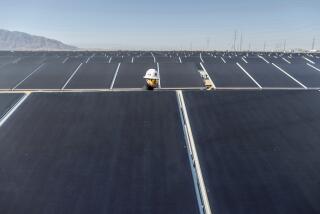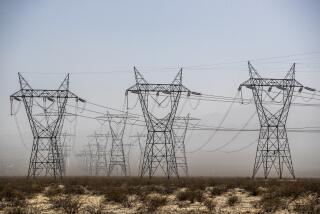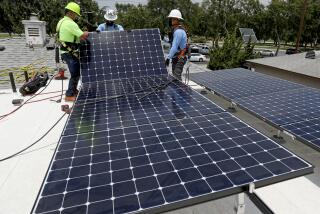Letters: Powering California
Re “Clean energy could choke the grid,” Dec. 3
The Times ignores the fact that extreme weather, not renewables, poses the biggest threat to the nation’s energy grid.
Regardless of the energy source, the grid requires smart management and investment. Predicting mechanical problems at the many aging power plants can be tricky. Imagine asking a mechanic to foresee every problem with a 40-year-old car.
System managers are becoming more sophisticated at forecasting weather patterns and are already integrating large quantities of renewables with no reliability impacts. Xcel Energy recently powered 60% of its system in Colorado with wind power. At one point this summer, California had enough solar capacity online to power a city 21/2 times the size of San Francisco.
Renewables can play an important role because they can mitigate climate change and, in the long run, help to reduce grid hazards and costs.
Noah Long
San Francisco
The writer is the Western Energy Project legal director for the Natural Resources Defense Council.
This article gives the misleading impression that renewable energy increases the risk of blackouts when, in fact, the problem is centralized, non-renewable power generation using fossil fuels.
California is a national leader in reliably increasing the use of renewables like solar and wind energy.
For example, despite the article’s claim that “nobody can say for certain when the wind will blow or the sun will shine,” the variability of wind and solar energy is being addressed through improved forecasting and new regional partnerships that better leverage the geographic diversity of wind and solar resources.
The article also might make readers believe that California regulators recklessly disregarded cost concerns in requiring utilities to deploy energy storage. This couldn’t be further from the truth. In fact, regulators adopted an energy storage requirement after an independent third-party analysis concluded that it was a cost-effective resource offering significant grid benefits.
California deserves praise for its leadership in increasing the use of renewable energy and proactively finding solutions to address any grid impacts.
Matt Vespa
San Francisco
The writer is a senior attorney at the Sierra Club Environmental Law Program.
Lest anyone get the wrong idea, the problem posed by green energy production is a grid “designed for the previous century.”
Our present system projects total consumption and calibrates output to match demand. Ironically, it resembles the command economy of the old Soviet regime, putting the proverbial cart before the horse in what proved to be an unsustainable model.
Let us learn from the error of our fallen comrades. Green energy may not prosper with a “command-style” grid, so let’s redesign the grid.
A smart grid is flexible, efficient and decentralized, with two fundamental properties. First, it is demand-driven, so that power is actually generated by use. Second, it is itself regenerative, capable of redesigning its own networked architecture to meet changing needs.
Impossible? Just think about the “mobility” of cellular transmission sites when using your iPhone.
Andrew Apter
Santa Monica
ALSO:
Letters: Mixing politics and tax breaks
Letters: Another exodus in the Mideast
Letters: Afghanistan? Not our problem.
More to Read
A cure for the common opinion
Get thought-provoking perspectives with our weekly newsletter.
You may occasionally receive promotional content from the Los Angeles Times.






